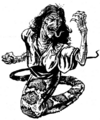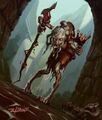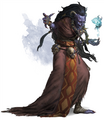Hag

Hags are a kind of monster from Dungeons & Dragons. At their root, they are based in the stereotypical Western beliefs about witches - namely, that they are hideously ugly old women who use their dark magical skills to cause suffering amongst mortals for kicks -- mingled with assorted European mythology about ugly but powerful and magical female giants and trolls, from the Nordic Jarnvidjar to British boogeywomen like the river-dwelling child-drowning Jenny Greenteeth and the iron-clawed man-flaying Black Annis.
Because of this, they initially began as a kind of Giant, only to be redesigned in later editions (around third or fourth) as being a kind of fae embodying nature's capacity for cruelty and ugliness.
Hags come in many, many varieties, from water-dwelling sea hags to brutishly powerful annis hags to seductive green hags to the fiendish night hags and more besides. They all have a love for evil and specialize in using magic, most notably innate affinities for illusion spells and physically shapechanging, to interact with mortals undetected, when they don't just enslave armies of goblins, ogres, orcs and other evil humanoids and rule them openly.
As an all-female race, hags need to mate with humanoid men in order to propagate. In older editions, in fact, hags grow up believing themselves to be normal human women, only transforming into hags when they reach about their 40s or 50s. The except to these are Night Hags, at least according to Dragon Magazine, whose children are normal (if often cambions or Half-Fiends, due to the night hag propensity for breeding with fiends), but must be deliberately transformed into new night hags before they hit puberty. In the Pathfinder setting, hags give birth to more human-like daughters called Changelings, who they must "persuade" to be magically transformed into more of their own kind. In 5e Hags kidnap and eat babies, giving birth to a daughter a week later. They then ether raise the child or return it to its parents and watch her grow up. At her 13th birthday the girl transforms into a spitting image of her hag mother.
Publication History
In the original Dungeons & Dragons, the sea hag first appeared in the Blackmoor supplement by Dave Arneson (1975). The Dungeons & Dragons Basic Set included its own version of the hag. The sea hag and the black hag appeared in the Dungeons & Dragons Master Rules (1985), and the Dungeons & Dragons Rules Cyclopedia (1991).
In Advanced Dungeons & Dragons 1st edition, the sea hag appears in the 1977 Monster Manual, where it is described as inhabiting thickly vegetated shallows, and hates beauty and is so ghastly in appearance that it makes other creatures weak with fright. The night hag also appears in the Monster Manual, where it is described as the ruler of the convoluted planes of Hades. The book states that night hags form larvae (the most selfishly evil of all souls who sink to lower planes after death) from evil persons they slay, and sell them to demons and devils. The Monster Manual was reviewed by Don Turnbull in the British magazine White Dwarf #8 (August/September 1978). As part of his review, Turnbull comments on several new monsters introduced in the book, referring to the night hag as "splendid" and notes that the illustration of the night hag is the best drawing in the book. The annis, a type of hag, first appeared in the module The Forgotten Temple of Tharizdun (1982). The annis appeared in the Monster Manual II (1983) along with the greenhag, which was detailed in Dragon #125 (September 1987), in "The Ecology of the Greenhag." The fresh water sea hag appears in Dragon #68 (December 1982).
In Advanced Dungeons & Dragons 2nd edition, the annis hag, the green hag, and the sea hag appear first in the Monstrous Compendium Volume Two (1989), while the night hag appears in the Monstrous Compendium Outer Planes Appendix (1991), and all are reprinted in the Monstrous Manual (1993),. The spectral annis, the spectral green hag, the spectral sea hag and the unique night hag Sytrix appeared in Ravenloft Monstrous Compendium Appendix III: Creatures of Darkness (1994). The night hag was further detailed in the first Planescape Monstrous Compendium Appendix (1994). The bheur hag for the Forgotten Realms setting first appears in Spellbound (1995), and then in Monstrous Compendium Annual Volume Three (1996). The article "Pox of the Planes" in Dragon Annual #2 (1997) described the night hags as the creators of the altraloths, powerful unique yugoloths.
In Dungeons & Dragons Third Edition, the annis, the green hag, and the sea hag appear in the Monster Manual for this edition (2000). The bog hag appears in Oriental Adventures (2001). Savage Species (2003) presented the annis hag, the green hag, and the sea hag as both races and playable classes. The bheur hag, the shrieking hag, and the hagspawn for the Forgotten Realms appear in Unapproachable East (2003).
In Dungeons & Dragons 3.5 edition, the annis, the green hag, the sea hag and the night hag appear in the revised Monster Manual for this edition (2003). The dusk hag for the Eberron campaign setting appears in the Eberron Campaign Setting book (2004). The Xtabay, hag inspired by Mayan legend, appeared in Dragon issue 317. The dune hag appears in Sandstorm: Mastering the Perils of Fire and Sand (2005). The marzanna appears in Frostburn: Mastering the Perils of Ice and Snow (2005). The green hag is further detailed in Dragon #331 (May 2005), in "The Ecology of the Green Hag,", and the annis hag is further detailed in Dragon #345 (July 2006), in "The Ecology of the Annis."
The hag appears in the 2008 Monster Manual for Dungeons & Dragons 4th edition, including the howling hag, the bog hag, the night hag and the death hag. The pact hag, the dream hag and the mist hag appeared in Monster Manual 3.
In 5th edition, the hag appears in the Monster Manual for Dungeons & Dragons 5th edition, consisting of the Night Hag, Green Hag and Sea Hag. The Annis Hag and Bheur Hag appeared in the subsequent Volo's Guide to Monsters
Subspecies
Hags in D&D come in many different species, as touched upon in their Publication History section above. But, as far as D&D is concerned, there are four species that are particular iconic; the Annis, the Green Hag, the Sea Hag, and the Night Hag.
Annis hags are the largest and strongest of their species. They tend to associate the most with giant-kin, such as ogres and trolls. They may not be particularly magically adept, but they're hard to kill and well-suited for rending victims limb from limb.
Green hags are the most "stereotypical" of the hags, with the general focus on spellcasting and shapeshifting. Their abilities often tend towards either the obvious enchanter route, or towards evil druidism, and they have a particular focus on using their powers of shapechanging and illusions to make lives miserable.
Sea hags are the weakest of their ilk, antisocial fishy loners who live along coastlines. They're generally considered to be the most hideously ugly of their ilk, to the point of being able to scare people to death with their faces in AD&D.
The fiendish Night Hags are an extraplanar branch of the family tree, who specialize in harvesting the souls of evil humanoids and trading them in infernal markets.
The Hannya are a species of hag introduced in Oriental Adventures, and are basically the hideously ugly bastard daughters of a hag and a lamia.
Bhuer Hags are native to the Forgotten Realms region of Rasheman, and not quite as evil as most hags. They are elementalists with an affinity for ice, and considered by the natives to be spirits of winter. At the very least, they often worship Auril. A similar icy hag, the Marzanna, appears in the Frostburn sourcebook.
Bog Hags are similar in many ways to Green Hags, but can't shapeshift; instead, they murder beautiful women and flay off their skins, which allows them to assume the form of their victims by wearing the hide. These hags are associated with the Oriental Adventures 3e sourcebook, and arguably are an immigrant from the Legend of the 5 Rings game and its setting of Rokugan.
Related Species
Gallery
-
The original artwork for the Bhuer in AD&D... yeah, apparently, this is the face of voracious winter incarnate.
-
The original artwork for the Hannya.
-
The Hannya as depicted in the 3e Oriental Adventures.
-
3e artwork for the Night Hag.
-
A bog hag; this art originates from the 3e Oriental Adventures sourcebook, and was later reused for its reappearance in 4e.
-
This creature was called the Dune Hag in 3e and the Death Hag in 4e.
-
3e artwork for the Bhuer and Shrieking Hag, with a Hagspawn in the center.
-
Pathfinder's take on the Annis.
-
The Winter Hag, a renamed Bhuer, appeared in Dragon Magazine #367 for 4e.
-
The Sea Hag from 5e is... weirdly less a crone and more a fish-woman.
-
5e went back to its roots for the Green Hag.
-
You can see the resemblance in the Night Hags of 3e and 5e.
-
5e made the Bhuer a lot more monstrous-looking.
-
5e saw the Annis take a whole new level in Jesus-Christ-What-the-fuck!?
| The inhabitants of the Planes of Planescape | |
|---|---|
| Upper Planes | Aasimon • Angel • Animal Lord • Archon • Asura • Eladrin • Guardinals • Lillend |
| Middle Planes | Formians • Githzerai • Inevitable • Marut • Modron • Rilmani • Slaadi • Kamerel |
| Lower Planes | Alu-Fiend • Baatezu • Bladeling • Cambion • Demodand • Erinyes • Hag • Hordling • Imp • Kyton • Loumara • Marilith • Obyrith • Succubus • Tanar'ri • Yugoloth |
| Transitive Planes | Astral Dreadnought • Githyanki |
| Inner Planes | Azer • Elemental • Genie • Grue • Mephit • Salamander • Sylph |
| Sigil | Dabus • Cranium Rat |
| High-ups | Archangel • Archdevil • Archfey • Archomental • Demon Prince |













